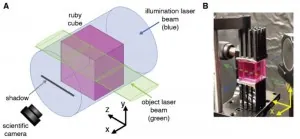
Unveiling Nature's Communication: How Cyanobacteria Harness AM Radio Mechanisms to Synchronize Life
2024-11-25
Author: Olivia
Introduction
Groundbreaking research has unveiled a stunning similarity between the biological rhythms of cyanobacteria and the technology behind AM radio transmission. These ancient photosynthetic bacteria have been discovered to use amplitude modulation—a principle we typically associate with radio waves—to regulate their cellular processes.
Key Findings
A recent study published in Current Biology reveals that cyanobacteria communicate and control their cellular activities through variations in the amplitude of pulsing signals. This innovative mechanism provides new insights into the complexities of cellular regulation.
AM Radio and Cyanobacteria
In the world of AM radio, a carrier wave generated by oscillating electric currents transmits information via changes in amplitude. The audio signals modulate the carrier wave, creating a complex interplay that delivers music and speech. Similarly, the research team, spearheaded by Professor James Locke from the Sainsbury Laboratory Cambridge University and Dr. Bruno Martins from the University of Warwick, demonstrated that a comparable mechanism operates within cyanobacteria.
Cell Division and Circadian Rhythm
In these micro-organisms, the cell division cycle acts as the "carrier signal," while the daily rhythm dictated by their 24-hour circadian clock provides the modulating signal. This discovery addresses a long-standing mystery in cell biology: how cells integrate inputs from two distinct oscillatory systems—the circadian rhythm and the cell cycle—each operating at different frequencies.
Research Methodology
To solve this intriguing problem, the research team employed single-cell time-lapse microscopy alongside advanced mathematical modeling. Their examination of a key protein, the alternative sigma factor RpoD4, revealed that it becomes active in defined pulses corresponding to cell division. This observation highlighted RpoD4 as a critical component for tracking the synchronization of the two rhythmic signals.
Significance of Findings
Dr. Chao Ye, the lead author, stated, "Our findings indicate that the circadian clock governs the intensity of these pulses, allowing cells to encode two types of information—data about the cell cycle and the 24-hour clock—within a single output. This is the first documented instance of a circadian clock employing pulse amplitude modulation, echoing principles of communication technology in biological processes."
Experimental Validation
To further validate their hypothesis, researchers manipulated environmental factors influencing either the cell cycle or the circadian clock. This experimentation perfectly illustrated the foundational principle of these cellular communication systems.
Nature's Ingenious Solutions
Dr. Martins noted, "It’s astonishing to witness nature employing what we often consider solely human engineering solutions, showcasing the complexity and ingenuity of biological systems."
Conclusion and Implications
With origins tracing back 2.7 billion years, cyanobacteria offer a remarkable example of adaptation and innovation. As Professor Locke emphasizes, the simplicity of their circadian clock is an advantageous platform for understanding the more complex clocks found in higher organisms, including humans and agricultural crops.
The implications of this research stretch beyond cellular biology; it opens new avenues in synthetic biology and biotechnology. The potential to engineer crops that respond more effectively to fluctuating environmental conditions could revolutionize agricultural practices, enhance food security, and promote sustainability in an ever-evolving world.
Future Research Directions
Stay tuned as we continue to explore the fascinating intersections of nature and technology!









 Brasil (PT)
Brasil (PT)
 Canada (EN)
Canada (EN)
 Chile (ES)
Chile (ES)
 España (ES)
España (ES)
 France (FR)
France (FR)
 Hong Kong (EN)
Hong Kong (EN)
 Italia (IT)
Italia (IT)
 日本 (JA)
日本 (JA)
 Magyarország (HU)
Magyarország (HU)
 Norge (NO)
Norge (NO)
 Polska (PL)
Polska (PL)
 Schweiz (DE)
Schweiz (DE)
 Singapore (EN)
Singapore (EN)
 Sverige (SV)
Sverige (SV)
 Suomi (FI)
Suomi (FI)
 Türkiye (TR)
Türkiye (TR)